The whirligigs soar 50 feet into the Carolina blue sky, fantastical kinetic sculptures that spin and rattle in the wind, cobbled-together contraptions of bicycle wheels, semi-truck hubs, school bus mirrors, metal goblets, ball bearings, steel rods, wood, aluminum sheeting, milkshake mixer cups, oil filters, waffle-iron parts, and the occasional Mickey Mouse piggy bank or metal duck — anything that retired farmer Vollis Simpson had salvaged over the years and left out in his fields in case it ever came in handy.

“[I] just go to the junkyard and see what I could get,” he told The New York Times in 2010. “Went by the iron man, the boat man, the timber man. Ran by every month. If they had no use for it, I took it.”
He collected air conditioner fans, ceiling fans, industrial fans — the biggest is 25 feet across — and covered them with reflective pieces of highway signs that he cut by hand, so that when light hits them at night, the sculptures dazzle like fireworks or church windows that spin. He swears he didn’t measure, didn’t weigh, yet each windmill, as he called them, moves with engineered precision.
“I don’t use a ruler much,” he said on YouTube. “I can go down there with a hacksaw and I can come within a damn eighth of an inch just guessing at it.”
Simpson was one of the greatest visionary artists in the country, says Roger Manley, director and curator of the Gregg Museum of Art + Design in Raleigh, North Carolina, and author of Signs and Wonders: Outsider Art Inside North Carolina. “I think he’s North Carolina’s greatest sculptor, not just great self-taught sculptor.”
Rebecca Hoffberger, the founder and recently retired director of the American Visionary Art Museum in Baltimore, agrees. “The level of Vollis’s imagination and the scale in which he was working is without precedent.”
Simpson trained himself on the math and mechanics to turn other people’s discards into brightly colored and whimsical Ferris wheels, clowns on bicycles, airplanes and rocket ships, men pulling a long saw, his son playing a guitar, ducks, horses, and dogs, all representations of his life as a farmer, father, and soldier.
“I call him kind of a modern-day Archimedes,” Manley says. “He had this sense of leverage and balance and, you know, where to lift things so they wouldn’t fall apart.”
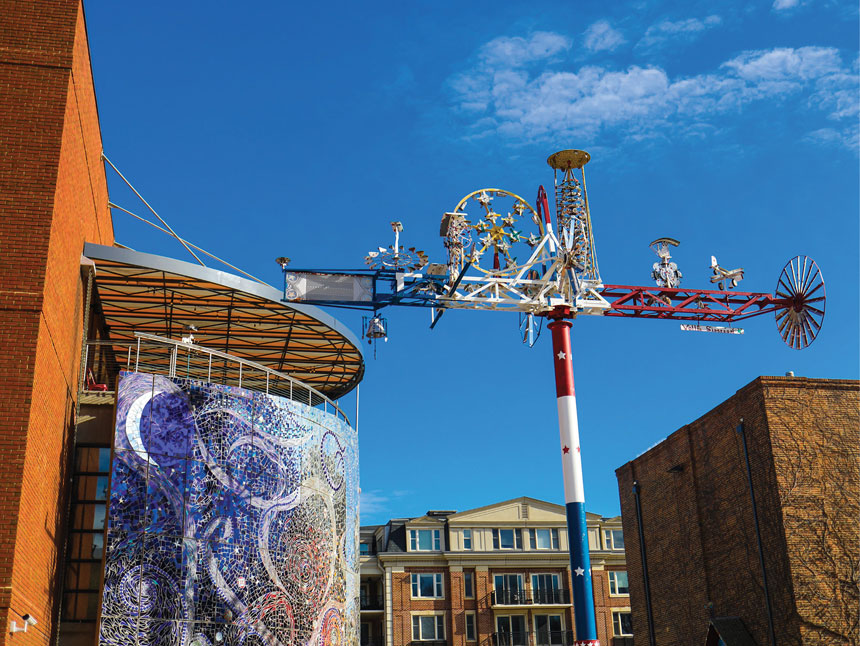
Simpson was one of 12 siblings, born in 1919 in tiny Lucama, North Carolina. His father was a farmer, but Simpson was more interested in the machinery, eventually building a business moving houses and heavy farm equipment. In 1941 he was serving in the military on the island of Saipan when he converted the propeller of a junked B-29 bomber into a windmill that powered a much-needed washing machine. Back on the farm, he invented crop sprayers and built 13 cranes by welding pulleys, booms, and gantries, Manley says, and attaching them to the back of Army surplus trucks. He used them to move brick buildings or huge factory machinery, to pick up combines stuck in the mud or — legend has it — a locomotive when it fell off a trestle bridge.
He was in his 60s when he started building whirligigs for the fun of it.
“He always told the family that that was his golf game,” says his son Mike Simpson. “People in the community would ride by and say, ‘I think Mr. Simpson’s lost his mind. He’s doing wild, crazy stuff.’ But he was not in it to impress anybody but himself. He got so much enjoyment out of building them, and then in his later years after he had put them up, he got a lot of enjoyment out of just sitting in his shop yard and watching the wind blow.”
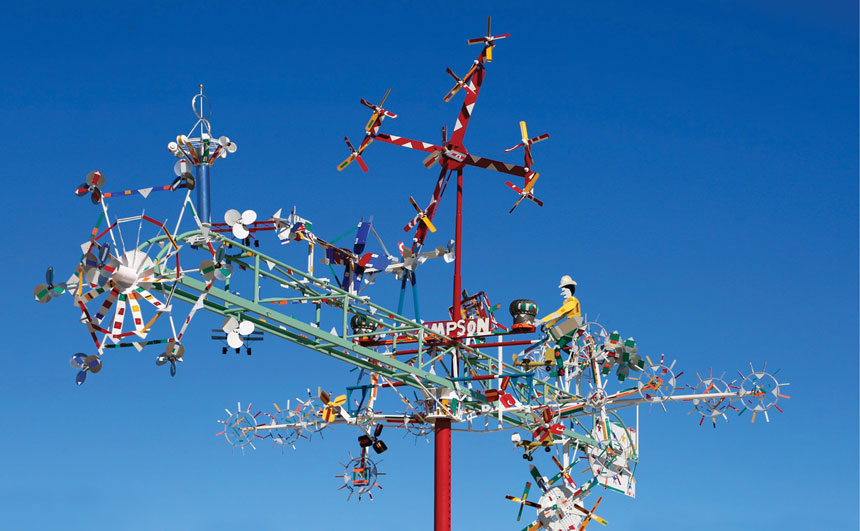
That shop was at the intersection of country roads, and locals would drive by at night, impressing their dates as they rounded the curve and their headlights lit up the kaleidoscope of color. Simpson would be sitting there, keeping watch, his son says, deterring vandals with an elaborate system of lights connected to a battery at his feet that he could cut on, lighting the whole field at once. He’d set off an old fire department siren, cover the ladders with tar, and set tripwires with shotgun shells, not to hurt anyone, just to get them to leave his whirligigs alone. During the day he’d entertain a steady stream of visitors from around the country and the world, selling them small whirligigs they carried off as souvenirs, laughing at their befuddling accents even though his own was country-thick.
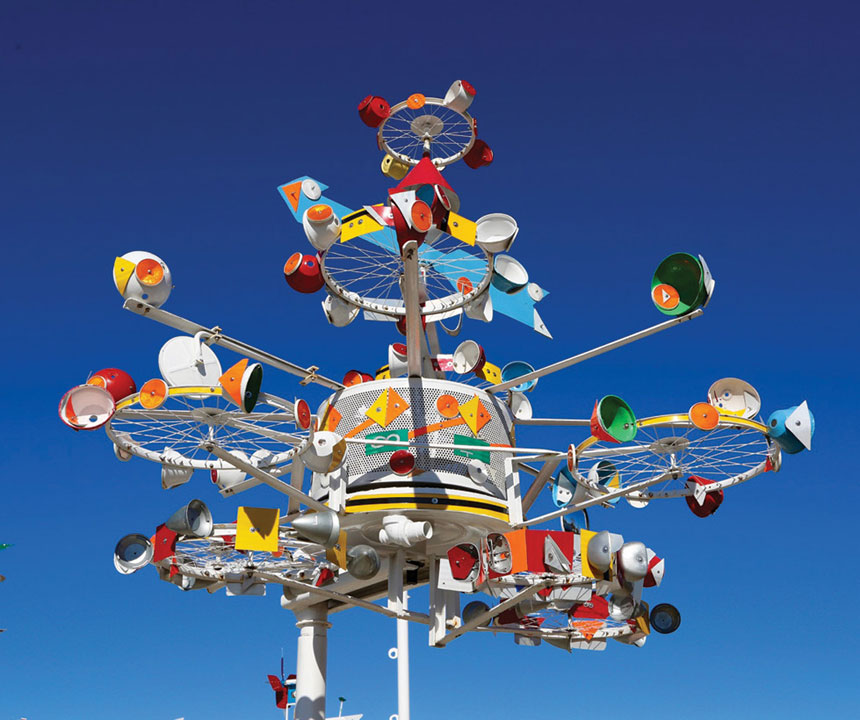
He had prestigious visitors as well. In the mid-1990s, Hoffberger was preparing to open the American Visionary Art Museum. She’d seen Simpson’s work in Manley’s book, and after Manley introduced the two, she commissioned Simpson to create a signature piece, the visual draw to her new museum. Manley drove Simpson to Baltimore to see the site. Simpson, who had never been out of his home state except during his military stint, didn’t know how to ride an escalator and had never seen multiple-crossover overpasses. “It was like taking somebody from back in time,” Manley said.
Simpson crafted the 55-foot Life, Liberty and the Pursuit of Happiness, repeatedly voted as the most beloved public art in Baltimore, so precisely calibrated for the space that it looks like visitors could reach out and touch it from the balcony.
He took his sons up to help install it in 1993, Hoffberger says, sinking an old Exxon pole 13 feet into the ground, Mike Simpson climbing on the structure while his father held a rope to keep the boom from swinging in the wind.
“He must have done that for well over three hours,” Hoffberger said. Then a staff member offered to give Simpson a break. “It took three of my young male staff to hold it, and they were only able to hold the boom for like a half-hour without being exhausted. And he had done it by himself. That’s how strong he was.”
Simpson was also smart. “If you listen to the man on YouTube, you would think he was dumb as a box of rocks,” says Mel Bowen, one of the men who maintain the sculptures. “But the man is not stupid. And he wasn’t lazy. He worked hard all his life.”
It’s not unusual for an outsider artist to begin late in life. “The magic age for late onset of creativity amongst visionary artists worldwide is 60,” says Hoffberger. “There’s something about that, like you’ve lived your life, and you know who you are, you don’t care so much what other people think.”
A self-taught artist may take a bulldozer into the California desert like Leonard Knight, who built the brightly colored Salvation Mountain, an homage to his faith that’s covered in half a million gallons of latex paint. Or weld together scrap metal like Tom Evermor, who spent 30 years on the 300-ton sculpture Forevertron in Sumpter, Wisconsin. Or they create smaller art, like Annie Hooper, who built renowned biblical scenes out of driftwood and concrete. Most, though, tinker with found objects, stacking stones into elaborate miniature towns, crafting a replica of a beloved church out of cigar boxes and scraps of tin and stained glass, or engineering a dairy maid who bows when the wind blows.
People call such works folk art, but folk art is craft handed down through a culture, Manley says. A grandmother passes along a love of quilting, local potters teach the next generation how to operate a wheel. There’s room for individual creativity, but the basics of the art form are established. “Outsider” or “visionary” artists invent a form for themselves. Manley, who has interviewed hundreds of self-taught artists, said their work is often connected to trauma. It’s usually made by men who had hands-on jobs. “It’s very unlikely that an insurance actuary or a school teacher will become a self-taught artist, because the kind of work they do is not tangible.” But farmers and loggers and textile workers can see what they’ve created, and they begin to associate themselves with their ability to produce. Then they get injured, or the company closes down. Most find another job, or they become self-destructive. “But there’s a tiny percentage of people whose response is to begin to make stuff, often with whatever they have at hand. They don’t think, Oh, I should sign up for an art class. They don’t even realize they’re artists. They just begin doing things that make them feel better.”
For Simpson, the moment came when a steel cable broke and landed him in the hospital. “I guess he lay there thinking, I’m doing all this stuff for everybody else but I’m not doing anything for me,” Manley said. “And he just started to make things to entertain himself.”
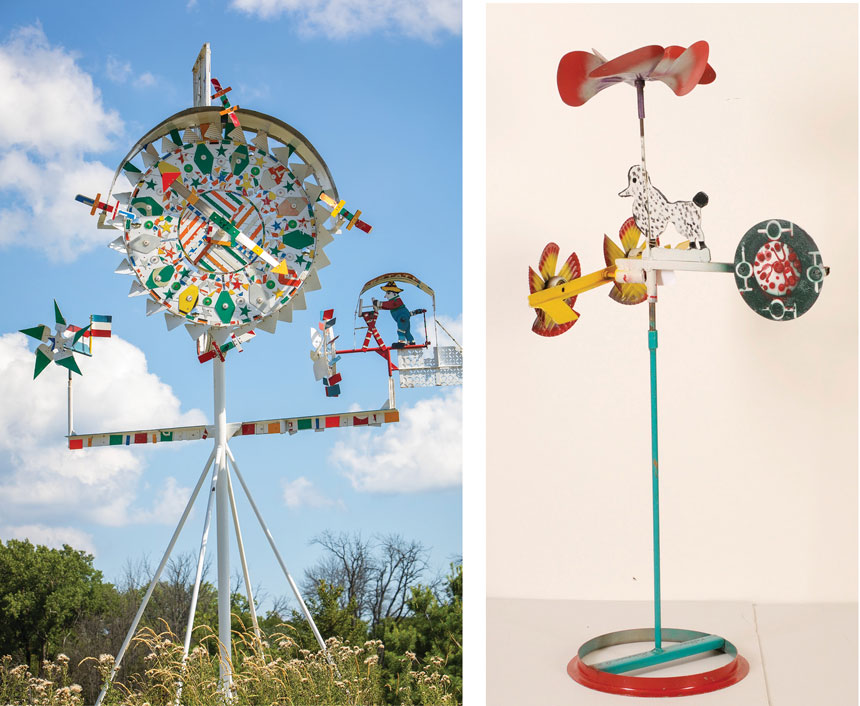
Simpson was well into his late 80s when his knees started giving him too much trouble to climb up and maintain the sculptures. That’s when the small North Carolina town of Wilson, 11 miles away, partnered with the Smithsonian Institution, Dupont, and the National Parks Service to restore and conserve the eye-popping pieces of art and erect them on the site of a long-gone tobacco warehouse.
It took eight years to get all of the whirligigs taken down, moved to one of the old warehouses, and taken apart, each piece numbered and then meticulously cleaned, the bearings repacked, the whole thing welded back together. At the beginning there were dozens of restorers, some professional and some trained on the job; today a crew of three keeps the art spinning.
After the opening of the Vollis Simpson Whirligig Park, public-private investment in downtown Wilson swelled from $1 million a year to more than $100 million three years later, according to Henry Walston, who was head of the nonprofit board behind the park. There’s a brewery, restaurants, and art galleries. A 100-year-old hotel boarded up for 20 years is being renovated as a boutique hotel and event space.
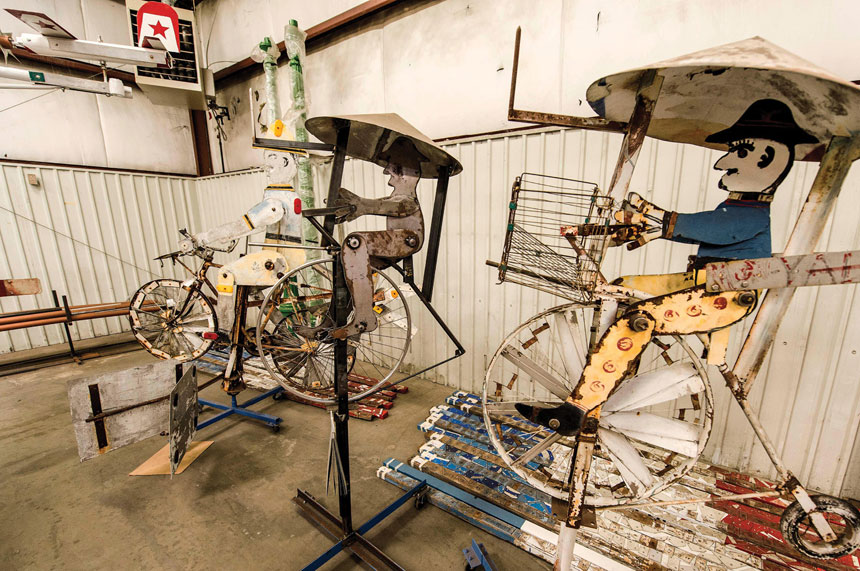
“With a lot of art projects, there’s a large segment of the public that kind of laugh about it and poo-poo it as a waste of money,” Bowen says. “Now some of the people who were the naysayers, they think it’s the finest thing in the world. People laughed at Vollis when he started building them, too. And he showed them. He became very famous.”
Simpson’s works were featured in a 2010 window display at New York’s Bergdorf Goodman department store. Four of his whirligigs loomed over the 1996 Olympics in Atlanta. They are in collections at the American Folk Art Museum in Manhattan, the Philadelphia Museum of Art, and the Los Angeles County Museum of Art. The Kohler Foundation — a major funder of the art’s preservation — has 12 in its collection at the John Michael Kohler Art Center in Sheboygan, Wisconsin.
In 2013, the state of North Carolina named his whirligigs the state’s official folk art. Simpson died that year at the age of 94. Today, they spin on without him.
Janine Latus has written for Smithsonian.com, Humanities, and O, The Oprah Magazine, among others. She is the author of the international bestselling memoir If I Am Missing or Dead and a frequent speaker on domestic violence. For more, visit janinelatus.com.
See more of Vollis Simpson’s sculptures at wilsonwhirligigpark.org.
This article appears in the March/April 2023 issue of The Saturday Evening Post. Subscribe to the magazine for more art, inspiring stories, fiction, humor, and features from our archives.
Become a Saturday Evening Post member and enjoy unlimited access. Subscribe now



